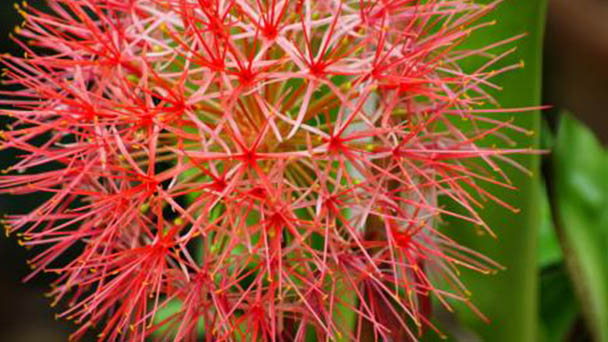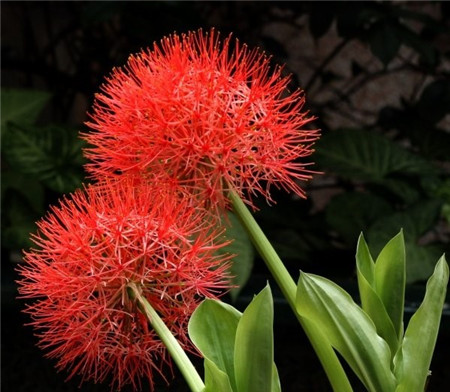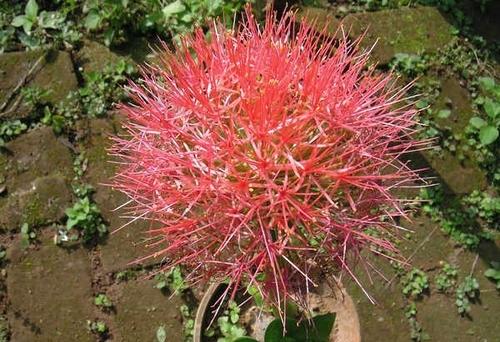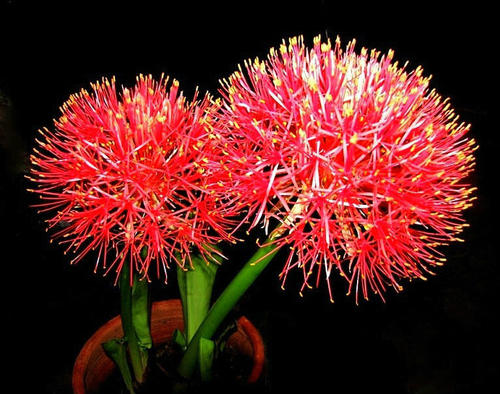Blood lily (Haemanthus multiflorus) profile
Written by Maggie
Sep 14 2021

Blood Lily (Haemanthus multiflorus) is a perennial herbaceous bulbous flower of Lycoris Blood Lily. Blood Lily has flat globular bulbs. With the rise of temperature at the end of spring, the leaves are drawn from the short stem at the upper part of the bulb in a stripe shape. When the leaf blade reaches 4-5 then spathe, the style has the light green spathe below. Globular umbel terminal, there are dozens to hundreds of inflorescences above the composition of bright red flowers, stamens longer than perianth, anthers yellow, look radiate like a ball. Blood Lily only blooms once a year, and the flowering period is in spring. A flower bulb lasts only about 10 days. After the flowers fade, it bears round berries.
Blood Lily is originally from the tropics. It likes the warm, humid and semi-cloudy environments, and is afraid of heat and cold.
Blood Lily Picture

Blood Lily Morphological Characteristics
Blood Lily is a perennial herbaceous flower with bulbous roots. The bulb is spherical with a diameter of 4-7 cm. The bulb is large and oblate. blood lily has 3-4 leaves, oblong, 15-30 cm long, main veins with 6-8 longitudinal veins on each side, transverse veinlets are closely arranged and oblique; Petiole is short, sheathlike, leaves broadly lanceolate, petiole base extended below the sheathlike.
Blood Lily flower stems are erect, solid first leaves extracted, slightly flattened, 30-90 cm tall, first leaves extracted, light green or with red spots; Umbels are multiflowered, densely arranged, 7 -- 15 cm in diam. Flowers are red; Umbels are terminal; The flowers are small, up to 30 to 100, mostly blood red.
Perianth tube is cylindric, 6-12 mm long, perianth lobes linear, ca. 2 times as long as perianth tube; Filaments are red, extending beyond perianth, anthers yellow. Berry is globular bright red.
Blood Lily Ecological Habits
Blood Lily likes a warm, moist and semi-cloudy environment, and likes sandy loam soil with good drainage. Blood Lily has drought resistance, not cold resistance, Nanjing, Shanghai, Hangzhou and other places are not open to winter, winter bulb into the dormant period must be cultivated indoors. The suitable temperature for the growing period is 20 ~ 30℃, and the overwintering temperature should be kept above 5℃. The soil should be loose, fertile and well-drained.
Blood Lily Care
Blood Lily Light Requirements
Blood Lily likes a sunny environment. When caring for Blood Lily, it should ensure no less than 4 hours of direct sunlight every day. Blood lily should not grow in shady, otherwise the plant will grow slowly and the color will be dim. You can fill it with fluorescent light at Blood Lily seedling stage.Blood Lily Temperature Care
The optimum growth temperature of Blood Lily is between 20 ℃ and 30 ℃. Therefore, when caring for Blood Lily, it is necessary to put it in a place with strong light and good ventilation, so that Blood Lily will be more robust. When the seeds of Blood Lily are sown, the growth temperature of the seeds should be controlled at more than 20 degrees Celsius, which will facilitate the germination of the seeds and thus improve their germination rate.Blood Lily Watering
Blood Lily likes slightly wet and dry soil environment and is more resistant to drought. When watering, it prefers dry rather than waterlogging. In the growth stage of Blood Lily seedlings, especially when they grow leaves, watering should be properly controlled, and the amount of watering can be appropriately increased after flower buds differentiate to ensure the normal growth of flowers.Blood Lily Fertilizer
Blood Lily is fond of fertilizer. In addition to adding sufficient base fertilizer into the soil during transplanting and applying phosphate and potassium fertilizer every half month during the peak growth period, which can not only promote the growth of Blood Lily plants, but also enhance the resistance and reduce disease infection.Blood Lily Pruning
Blood Lily grows rapidly, plucking the heart once when the seedlings are 15 cm long to promote branching. Then, according to the growth of the plant, decide whether to pick the heart for the second time, control the plant type and flowering time. In addition, in the growth process of Blood Lily, the yellowing and wilting leaves should be cut off in time, and the branches and leaves should be properly thinned to ensure the beautiful plant shape.Blood Lily Flowering Care
After Blood Lily flowers, mainly keep the pot soil moist, do not water from top to bottom, to avoid water on flowers. Stop fertilizing Blood Lily during flowering to ensure adequate light. After the flowers wither, cut off the flowers in time to promote the re - flowering branches.Blood Lily Soil Care
Blood Lily is easy to cultivate and has no strict requirements on soil, but grows best in deep and fertile sandy loam.Blood Lily Propagation
Blood Lily usually propagates by dividing the ball and sowing seeds.
Ball propagation
When changing the pot in the spring, the boy ball around the cue ball can be separated from the dividing plant; Bulbs of Blood Lily are usually propagated once every 2 ~ 3 years due to poor ability of bulb formation.
Seed propagation
After 50 ~ 60 days after the flower, the seed of Blood Lily is picked when the seed is mature, and the seed is planted along with the harvest. The pot is used for sowing. After sowing, the seedlings germinate for about 15 days. Spring is the planting period, a multi-purpose pot, can also be planted. In spring, the big balls were planted separately, the big balls were used for flowering, and the small balls were cultivated and grew up. Covering soil to avoid deep-buried, bulb germination, watering to moderate, can not let the basin water. Growing season every 10 days fertilization 1 time, summer light is too strong, put half shade conservation. At the beginning of autumn and winter, the leaf begins to wither and yellow, the bulb enters a dormant period, should gradually stop watering, keep the soil dry and dig out the bulb to store indoors.

Blood Lily Disease Control
The soil should not be too wet during the growth period of Blood Lily, otherwise, nematodes are likely to occur in the bulb and lead to bulb decay. Before planting, bulbs can be disinfected by soaking them in 0.5% formalin solution for 3 hours, and subterranean slugs can be killed by spraying them with 3% lime water.
Blood Lily Varieties
Some species of Blood Lily have common names, such as Natal Paintbrush, Catherine Wheel, Giant Paintbrush and African Blood Lily.
Blood Lily Distribution
Blood Lily is originally from tropical Africa. It can be found wild only in Yunnan in China. It is suitable for indoor cultivation in the middle and lower reaches of the Changjiang River.
Blood Lily Uses
Ornamental value
Blood Lily has bright colors, such as red, white and bright red. Dense flowers, such as balls, are common indoor potted ornamental open flowers. Outdoor clusters in the south are arranged in pieces, and the flowering landscape has a unique style. Blood Lily has bulbs, but it is not a lily. It has been born as a summer flower, but it also prefers the intense warmth and humidity of the south. You can certainly imagine African humans with their hair in small curls. So you can imagine what Blood Lily looks like. Blood Lily is suitable for potted ornamental, garden ornament beautification.
The material of cut flower
Blood Lily is suitable for indoor cultivation in the middle and lower reaches of the Changjiang River. Its flowers are large and colorful, and its ornamental effect is excellent. It can also be used as cut flower material.
Medicinal value
The bulb of Blood Lily has little poison but also has a medicinal function, can reduce swelling and relieve pain.

Latest Updated
- Benefits of Bugleweed - 7 Science-backed Health Benefits
- Bugleweed Dangers & Side Effects - Is It Poisonous?
- How to Plant Evergreen Trees - What You Should Know
- When to Plant Evergreens - Grow Guide for Evergreen Trees
- 12 Wonderful Evergreen Shrubs for Your Garden
- 12 Popular Evergreen Plants with Pictures for Beginners
- When And How To Prune A Lilac Bush Like a Pro
- How to Grow & Care for Lilac Vine (Hardenbergia Violacea)
- Japanese Lilac Tree (Syringa Reticulata) Care & Propagation Guide
- Shumard Oak Pros and Cons - What to Know
Popular Articles
- Winter maintenance of Antirrhinum Majus
- How to Grow Terminalia Mantaly Tree
- How to Grow and Care for Crossostephium Chinense
- How to grow Antirrhinum Majus in spring
- Peristeria Elata (Dove Orchid) Profile: Info & Care Guide
- Underwatered Snake Plant (Sansevieria Trifasciata) - Signs And How To Fix
- How to Care for Brazilian Jasmine Plant (Mandevilla Sanderi)
- How to Grow & Care for Graptopetalum Purple Delight in Summer
- Rosa Chinensis (China Rose): Plant Growing & Care Tips
- How to Care for Baby Sun Rose (Aptenia Cordifolia)